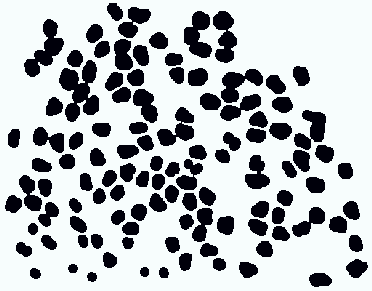
Binary image of cells
The determination of the area distribution of cells in an image is a common operation in Image Analysis. Image Analysis applies to operations performed on images (2D data) to make quantitative measurements in order to describe an image. That is, we want to extract certain features of an image. A feature is an attribute (primitive) that is used to make decisions about objects in an image. Some primitives are natural and are defined by the visual appearance of the image. There are other features called artificial features and are a result of operations performed on an image. The procedures applied for image analysis are application-oriented. That is, what it is good for one application may not be suitable for another. An important concept not to forget is that procedures on the data will not increase the information content of the original data.
A procedure to calculate the area distribution of cells is presented here. The binary image for our experiment is shown below.
The first step is to label the image, i.e., a process where each connected region is assigned a unique value. The labeling algorithm runs in a raster scan order so that the regions are sequentially numbered from top-left to bottom-right of the image. The maximum value in the labeled image gives the total number of connected regions in the image.
The histogram of the labeled image gives the area corresponding to each connected region. From the histogram we observe that the region with the largest area corresponds to 1359 pixels. NOTE: the background is also a connected region but does not carry valuable information for this experiment. Make sure your histogram skips the background or region 0. Also, by obtaining statistics of the labeled image we observe that there are 105 distinct regions.
We can again take the histogram of the histogram. This allows us to group cells into different classes. By modifying the bin size parameter in the calculation of a histogram we can determine the number of regions that fall within different groups. For instance if we set the bin size parameter to 400, the new histogram provides the number of regions that fall in the following area ranges or groups:
class area n. of regions ------------------------------------ 0 0- 399 88 1 400- 799 15 2 800-1199 1 3 1200-1599 1 ------------------------------------